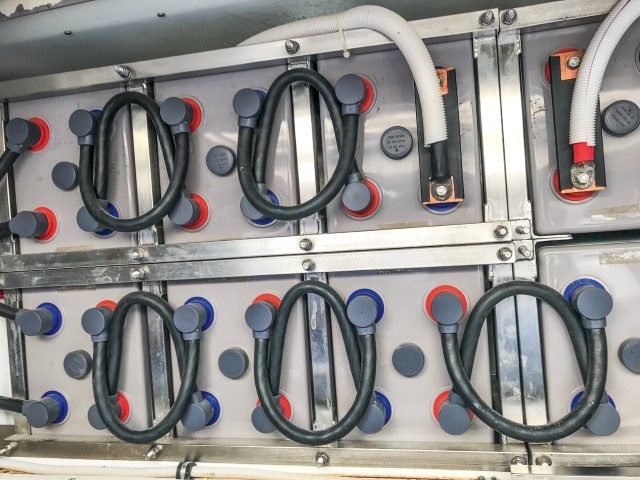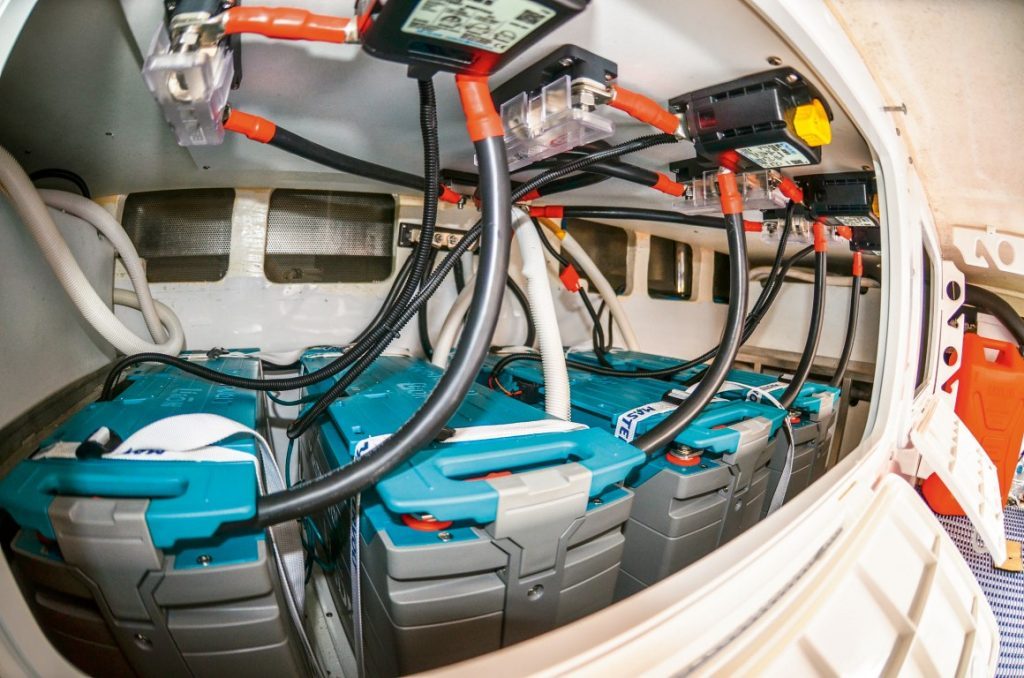

“Lighter, smaller, stronger” may be a well-worn tagline for new technology, but it’s a very relevant description for the new battery systems now available to power your boat, writes Mark Seabrook.
When R Marine Flagship’s Service Manager Adam Hadfield was asked by a customer to replace a 24-volt battery bank in his Riviera 70, due to loss of capacity and depth of charge, it was the perfect time to consider new battery technology. “The previous AGM power system provided battery storage for 50% of a total of 1,200 amp-hours, or 600 available amp-hours. The batteries weighed 1,200kg and their footprint took up more than a square metre,” recounts Adam. The decline in the batteries was most apparent at night, when the falling voltage automatically triggered the genset to start – waking everyone on board.
He and the owner elected to swap the old batteries with a Mastervolt lithium-ion alternative. The company’s technology is highly regarded – and is particularly well-proven in the gruelling conditions of the Volvo Ocean Race.
Flagship installed four Mastervolt MLI Ultra 24/5000 batteries for a combined 720 amp-hours. These batteries can be cycled down to 80% discharge, giving 576 available amp-hours. The most obvious advantage of the new system is the reduction in weight. The original AGM batteries weighed 1,200kg – the lithium-ion equivalent is just 290kg. This weight saving alone raised the transom 70mm out of the water, providing additional boat performance and economy, not to mention way more space in the lazarette. The previous battery footprint was 855mm x 1,450mm, versus the lithium-ion system’s 622mm x 788mm – a 50% reduction in space.

Recharge time is also impressive. A typical AGM system can take 5-7 hours to get from 50% discharge to full and the last 10-15% seems to take forever. The lithium-ion batteries can be charged in half that time. “With a similar 1,200 amp-hour lithium-ion system upgrade, using dual engine alternators throwing out 350 amps, you can get from 80% discharge to 100% in 2.5 hours”, says Adam. “And there is no memory effect or slow charge phase.”
The new batteries also offer greater ‘independence.’ There is less reliance on auxiliary engines and gensets – a saving on weight, space, and fuel – and the low hum of noise pollution across a secluded anchorage is eliminated. The faster recharge time from the main engine alternator replaces the need for a generator. Simply motoring to the next fishing spot or moving to another bay returns 80-90% of the system charge to power the boat through the night.
Battery life is as important as its performance – and it has a direct effect on the maintenance schedule (and the owner’s wallet). Battery life is determined by how many charge/discharge cycles it endures. On average, traditional batteries can cycle 500-600 times over a 3-4-year period – the lithium-ion equivalent can provide up to 3,000 cycles.
If managed correctly, lithium-ion batteries, have a life span of at least 10 years. In reality, the average recreational boat user could take more than 15 years to clock up 3,000 cycles – three times the cycles and lifespan of traditional batteries.
Lithium-ion explained
Most cranking and deep-cycle batteries use a combination of lead plates and sulfuric acid (electrolyte) to store electrical energy in liquid form. There are three common types of lead-acid batteries: flooded (or wet cell), gel cell, and absorbed glass mat (AGM).
When lithium-ion emerged as a battery technology in the early 70s there were concerns around its volatility. But it has evolved and safety margins are now so conservative we use lithium-ion daily in cell phones. Handheld electronics mostly use lithium-ion batteries based on lithium cobalt oxide (LiCoO2), which offers high energy density but can present safety risks, as Samsung found out in 2016 with its Galaxy Note 7 battery ‘challenges’.
Mastervolt batteries use lithium-ion phosphate (also known as LiFePO4), which offers lower energy density but longer life, greater stability and is the safest known chemistry for lithium-ion batteries. As with all lithium-ion batteries, the charge/discharge cycling process needs to be monitored and managed. Mastervolt batteries have the battery management system built into each battery, including safety switches for protection.

“There are a lot of ageing electrical systems out there,” says Adam, “and this is compounded by an ever-increasing power demand for more appliances, bigger screens, new chartplotters and devices of all kinds. A good way to view an upgrade – or to simply maintain a boat’s current electrical system – is to ask the ’10-year boat question’: If you plan to own your boat for the next 10 years, an investment in this technology will serve you well – both in cost and benefit. In simple terms, the increased usable capacity and lifespan of lithium-ion more than offsets the increased cost of the investment over a traditional battery technology.”
He is quick to point out that the technology is not a direct drop-in replacement solution – it’s an integrated system. The key components for lithium-ion battery technology replacement include: a high-output alternator, a smart regulator and monitoring instruments, as well as ‘higher-rupture’ fusing. Adequate ventilation and breathing space between batteries still applies, though orientation of lithium-ion batteries is not a problem as they can be positioned on their side and in any direction – ideal for heeling yachts.
A Happy Camper
Auckland yachtie Matthew O’Donoghue is a relatively recent convert to lithium-ion – having equipped his Roberts 53 ketch Defiant with the battery technology two year ago.
He reckons it’s the best present he’s ever given the boat, though it took a while before the penny dropped.
He initially fitted four 250 Ah Toyama hybrid batteries in 2005, as well as a 200-amp alternator to the main engine, and a 200-amp 230VAC battery charger, which could be driven off the 12kVA genset. He would only let the batteries run down to 75% before recharging to give them a reasonable life.
The 230V refrigeration system took the bulk of the energy onboard while he was cruising the Pacific. Because the charging current drops off as the batteries pick up, they took hours to recharge. Every time one of the refrigeration compressors started the low-voltage alarm on the inverter went off. Eventually, the batteries cried Enough! and he opted to replace them with three 300 Ah lithium-ion batteries.

One of the great advantages was the increased wine cellar space in the bilge, followed by the vastly-reduced charging time – eight hours reduced to one hour, as you can keep throwing additional charging current, and it readily accepts it. He could pump in almost 400 amps with both the engine and genset running. This would continue until the batteries were at about 95% and then the charge rate would start to drop off. Another plus is that the lithium-ion batteries maintain 13.2 volts until they are almost flat.
“Although they are considerably more expensive, I think they are the way to go, and these batteries will probably outlast me!”




